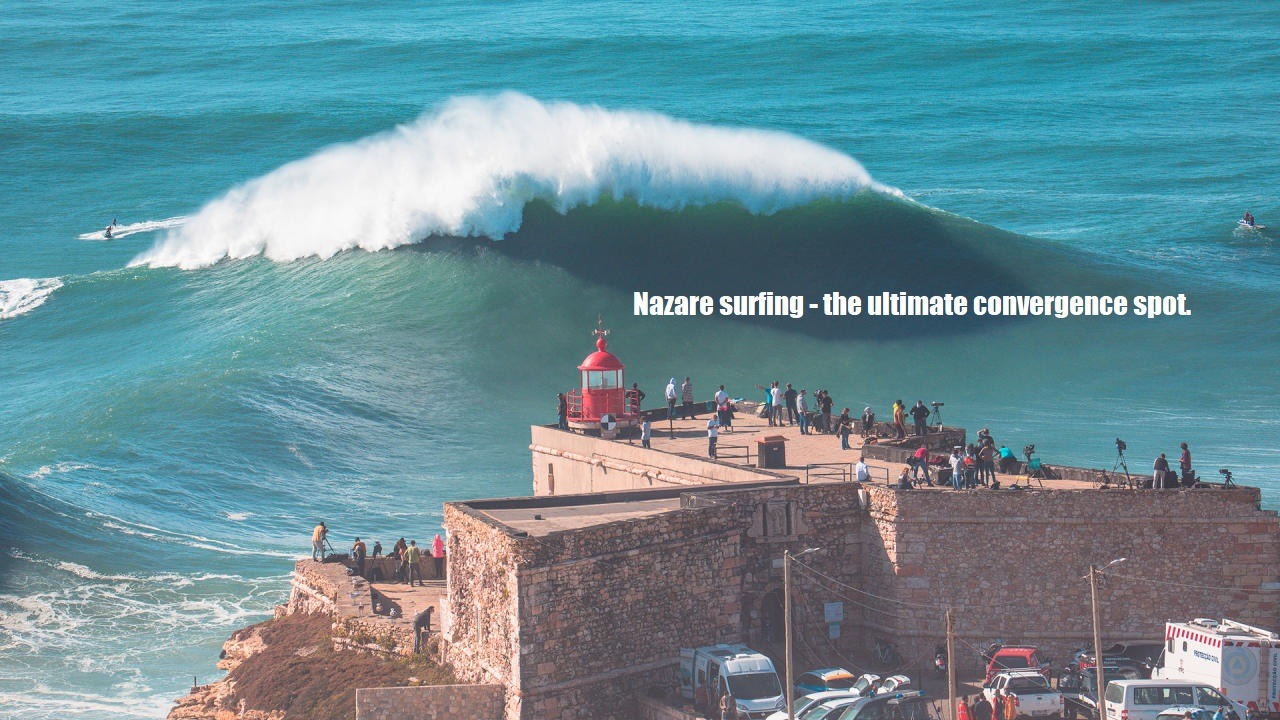Nazare (Praia do Norte), Portugal, and the big waves you see breaking there are nothing short of incredible. It’s an amazing spot that features the ultimate in convergence swell surfing. We’ve talked about convergence before. And how this phenomena can sometimes turn a seemingly flat day into something worth waxing up for. But that article was mainly focused on small waves. Nazare is something altogether different.
Nazare Canyon surfing.
Nazare’s monster swell occurs because of the underwater bathymetry. A deep canyon runs straight offshore for 210km at a depth of 5000m. Closer to shore it’s 20m in depth. This deep water channel serves to focus wave energy pulsing in from out at sea.
With the arrival of a powerful W-NW swell the Nazre Canyon and associated bathymetry cause the following to happen.
The refraction of the wave, due to the difference in depth between the continental shelf and the submarine canyon, leads to a change in its direction and speed.
Overtopping a topographic barrier (steep vertical variation). The abrupt depth reduction leads to a shoaling effect on the wave (reduction of wavelength and increase of wave height). This effect occurs gradually with the approach of a wave to the shore.
Positive interference between the wave traveling from the canyon and the wave propagating across the northern continental shelf. This effect promotes a new increase in wave height at the intersection of the two wavefronts.
Littoral drift. The wave propagation promotes a current, flowing along the beach with a northerly direction, which deflects offshore near the cape, acting as a topographic barrier. This current is enhanced by the water pile-up in the cove. The current, flowing in the opposite direction to wave propagation, intercepts the wavefronts, leading to an additional increase of the shoaling effect. The combined effect of these processes significantly increases wave height, which can reach much higher levels than those observed offshore. These waves break when their height is approximately equal to the local water depth. The results are spectacular, with giant waves breaking on the cliffs of the headland.
Info pulled from the Portuguese Hydrographic Institute.
When all of the above combines the differences in water depth between the continental shelf and canyon means wave energy is amplified and forced upwards into towering peaks. This is classic convergence. Albeit on a mammoth scale. Water is additionally forced north to south slamming straight into oncoming swell. This also serves to pump up breaking wave height. Thereby contributing to overall swell size.
In a nutshell: water depth differences ramp up wave height; Nazare’s canyon focuses, increases and converges the swell; water current inshore shapes the world’s biggest (and one of the gnarliest) waves.
Other convergence surf spots.
There are, of course, other convergence surfing locations to be found globally (The Wedge at Newport Beach is one). But nothing in the same vein as Nazare. (As far as we’re aware). This could change as who knows what’s lurking around the next headland waiting to be discovered.
Next time you head to your local surf spot take some time to observe how the waves form and break. Keeping the above in mind you may suddenly discover your local shares similar traits (on a smaller scale) to that of Nazare or The Wedge. This understanding will help you surf these waves better and more efficiently.
For more articles like this check out the following –

